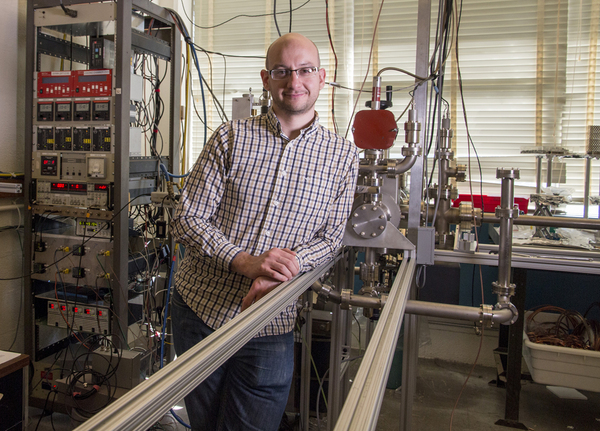CLASSE NEWS |
10 Oct 2017
Jared Maxson - Creating Small Beams and Big Collaborations

Jared Maxson, standing in the photoemission lab in Newman Hall
Jared Maxson has joined CLASSE as an assistant professor leading the photoemissions lab in Newman Hall along with Ivan Bazarov. The lab combines the use of detailed beam simulations with the design, construction, and operation of accelerator hardware with high resolution beam diagnostics. He is also an integral member of the Center for Bright Beams, where he focuses on beam production and beam transport and storage.
The first aim of the photoemissions lab is to continue the promising work of Ivan Bazarov and Luca Cultrera to make "version II" of the
photoinjector developed by former graduate student Hyeri Lee. Once this gun is online, it will enable multiple studies of beam dynamics within Newman Hall.
Using the enhanced photoinjector, the lab will work to create smaller beams of electrons than what are readily available. By using a very short laser pulse to generate the beams, and then further compressing them in time, the lab will research the process known as Ultrafast Electron Diffraction. This method allows researchers to work in time scales that are small enough to be able to map out the vibration of atoms inside of materials, which happens on the scale of hundreds of femtoseconds to mere picoseconds (10^-12 s) or faster.
"Once you study the beam... you can do some very interesting experiments with the electrons interacting with materials themselves. Just as X-rays are excellent probes of the atomic world, electrons also can be used for much of the same science", Maxson explains.
What seems most promising about the power of ultrafast electron diffraction is that the hardware needed can fit inside of a basement and within the budget of a typical university. You do not need a large-scale facility to accommodate this type of research. Maxson's lab will collaborate with other facilities to promote the usefulness of the design.
Ultrafast Electron Diffraction is not new, and other labs are working to develop this tool. But what sets CLASSE apart, Maxson explains, is that "CLASSE is a world leader in bright photocathodes. The electrons from our photocathodes have very low transverse momentum--perhaps some of the lowest in the field. Unlike other labs, we use lower energy electron guns, and concentrate our efforts on materials development."
Ideally, researchers could combine the efforts of low transverse momentum photocathodes, with higher energy sources. This type of collaboration is at the heart of the Center for Bright Beams, where partnerships such as chemists who grow the photocathodes and the microscopists who use these types of tools, can enable the collaboration to truly build a brighter beam.
These types of collaborations are what Maxson hopes to nurture here at CLASSE and within CBB, while also building the tools needed for researchers to explore even further.

